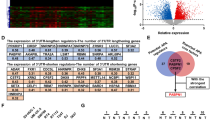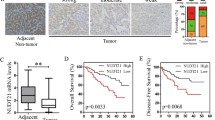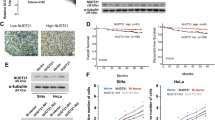Abstract
Cleavage and polyadenylation specificity factor 1 (CPSF1), a member of CPSF complex, has been reported to play a key role in pre-mRNA 3′-end formation, but its possible role in ovarian cancer remains unclear. In the present study, we found the mRNA level of CPSF1 was overexpressed in ovarian cancer tissues using Oncomine Cancer Microarray database. Then the loss-of-function assays, including CCK-8, colony formation and flow cytometry assays, were performed to determine the effects of CPSF1 on cell viability, proliferation, cell cycle and apoptosis of human ovarian cancer cell lines (SKOV-3 and OVCAR-3). The results indicated that depletion of CPSF1 suppressed cell viability, impaired colony formation ability, induced cell cycle arrest at G0/G1 phase and promoted cell apoptosis in ovarian cancer cells. Furthermore, knockdown of CPSF1 upregulated the expression of cleaved caspase-3 and PARP and downregulated CDK4/cyclin D1 expression. These data suggested that CPSF1 could promote ovarian cancer cell growth and proliferation in vitro and its depletion might serve as a potential therapeutic target for human ovarian cancer.





Similar content being viewed by others
References
Aragaki M, Takahashi K, Akiyama H, Tsuchiya E, Kondo S, Nakamura Y and Daigo Y 2011 Characterization of a cleavage stimulation factor, 3’ pre-RNA, subunit 2, 64 kDa (CSTF2) as a therapeutic target for lung cancer. Clin. Cancer Res. 17 5889–5900
Bolli N, Payne EM, Rhodes J, Gjini E, Johnston AB, Guo F, Lee JS, Stewart RA, Kanki JP and Chen AT 2011 cpsf1 is required for definitive HSC survival in zebrafish. Blood 117 3996–4007
Bonome T, Levine DA, Shih J, Randonovich M, Pise-Masison CA, Bogomolniy F, Ozbun L, Brady J, Barrett JC, Boyd J and Birrer MJ 2008 A gene signature predicting for survival in suboptimally debulked patients with ovarian cancer. Cancer Res. 68 5478–5486
Calzado MA, Sancho R and Munoz E 2004 Human immunodeficiency virus type 1 Tat increases the expression of cleavage and polyadenylation specificity factor 73-kilodalton subunit modulating cellular and viral expression. J. Virol. 78 6846–6854
Chen W, Guo W, Li M, Shi D, Tian Y, Li Z, Wang J, Fu L, Xiao X, Liu QQ, Wang S, Huang W and Deng W 2013 Upregulation of cleavage and polyadenylation specific factor 4 in lung adenocarcinoma and its critical role for cancer cell survival and proliferation. PLoS One 8 e82728
Cools J, Stover EH, Wlodarska I, Marynen P and Gilliland DG 2004 The FIP1L1-PDGFRalpha kinase in hypereosinophilic syndrome and chronic eosinophilic leukemia. Curr. Opin. Hematol. 11 51–57
Danckwardt S, Hentze MW and Kulozik AE 2008. “3’ end mRNA processing: molecular mechanisms and implications for health and disease. EMBO J. 27 482–498
Dominski Z, Yang XC, Purdy M, Wagner EJ and Marzluff WF 2005 A CPSF-73 homologue is required for cell cycle progression but not cell growth and interacts with a protein having features of CPSF-100. Mol. Cell Biol. 25 1489–1500
Gotlib J, Cools J, Malone JM 3rd, Schrier SL, Gilliland DG and Coutre SE 2004 The FIP1L1-PDGFRalpha fusion tyrosine kinase in hypereosinophilic syndrome and chronic eosinophilic leukemia: implications for diagnosis, classification, and management. Blood 103 2879–2891
Heintz AP, Odicino F, Maisonneuve P, Beller U, Benedet JL, Creasman WT, Ngan HY and Pecorelli S 2003 Carcinoma of the ovary. Int. J. Gynaecol. Obstet. 83 135–166
Hendrix ND, Wu R, Kuick R, Schwartz DR, Fearon ER and Cho KR 2006 Fibroblast growth factor 9 has oncogenic activity and is a downstream target of Wnt signaling in ovarian endometrioid adenocarcinomas. Cancer Res. 66 1354–1362
Jemal A, Bray F, Center MM, Ferlay J, Ward E and Forman D 2011 Global cancer statistics. CA Cancer J. Clin. 61 69–90
Karst AM and Drapkin R 2010 Ovarian cancer pathogenesis: a model in evolution. J. Oncol. 2010 932371
Keller W, Bienroth S, Lang KM and Christofori G 1991 Cleavage and polyadenylation factor CPF specifically interacts with the pre-mRNA 3’ processing signal AAUAAA. EMBO J. 10 4241–4249
Kiefer H, Mizutani A, Iemura S, Natsume T, Ando H, Kuroda Y and Mikoshiba K 2009 Inositol 1,4,5-triphosphate receptor-binding protein released with inositol 1,4,5-triphosphate (IRBIT) associates with components of the mRNA 3’ processing machinery in a phosphorylation-dependent manner and inhibits polyadenylation. J. Biol. Chem. 284 10694–10705
Kleiman FE and Manley JL 2001 The BARD1-CstF-50 interaction links mRNA 3’ end formation to DNA damage and tumor suppression. Cell 104 743–753
Koga M, Satoh T, Takasaki I, Kawamura Y, Yoshida M and Kaida D 2013 U2 snRNP is required for expression of the 3’ end of genes. Plos One 9 e98015
Legge F, Ferrandina G, Salutari V and Scambia G 2005 Biological characterization of ovarian cancer: prognostic and therapeutic implications. Ann Oncol 16(Suppl 4) iv95–101
Lu KH, Patterson AP, Wang L, Marquez RT, Atkinson EN, Baggerly KA, Ramoth LR, Rosen DG, Liu J, Hellstrom I, Smith D, Hartmann L, Fishman D, Berchuck A, Schmandt R, Whitaker R, Gershenson DM, Mills GB and Bast RC Jr 2004 Selection of potential markers for epithelial ovarian cancer with gene expression arrays and recursive descent partition analysis. Clin. Cancer Res. 10 3291–3300
Murthy KG and Manley JL 1995 The 160-kD subunit of human cleavage-polyadenylation specificity factor coordinates pre-mRNA 3’-end formation. Genes Dev. 9 2672–2683
Rozenblatt-Rosen O, Nagaike T, Francis JM, Kaneko S, Glatt KA, Hughes CM, LaFramboise T, Manley JL and Meyerson M 2009 The tumor suppressor Cdc73 functionally associates with CPSF and CstF 3’ mRNA processing factors. Proc Natl Acad Sci U S A 106 755–760
Siegel RL, Miller KD and Jemal A 2016 Cancer statistics, 2016. CA Cancer J. Clin. 66 7–30
Steinman RA 2007 mRNA stability control: a clandestine force in normal and malignant hematopoiesis. Leukemia 21 1158–1171
Topalian SL, Kaneko S, Gonzales MI, Bond GL, Ward Y and Manley JL 2001 Identification and functional characterization of neo-poly(A) polymerase, an RNA processing enzyme overexpressed in human tumors. Mol. Cell Biol. 21 5614–5623
Yang Q and Doublie S 2011 Structural biology of poly(A) site definition. Wiley Interdiscip. Rev. RNA 2 732–747
Ye D, Luo H, Lai Z, Zou L, Zhu L, Mao J, Jacob T, Ye W, Wang L and Chen L 2016 ClC-3 chloride channel proteins regulate the cell cycle by up-regulating cyclin D1-CDK4/6 through suppressing p21/p27 expression in nasopharyngeal carcinoma cells. Sci. Rep. 6 30276
Author information
Authors and Affiliations
Corresponding author
Additional information
Corresponding editor: Sorab Dalal
Rights and permissions
About this article
Cite this article
Zhang, B., Liu, Y., Liu, D. et al. Targeting cleavage and polyadenylation specific factor 1 via shRNA inhibits cell proliferation in human ovarian cancer. J Biosci 42, 417–425 (2017). https://doi.org/10.1007/s12038-017-9701-x
Received:
Accepted:
Published:
Issue Date:
DOI: https://doi.org/10.1007/s12038-017-9701-x




